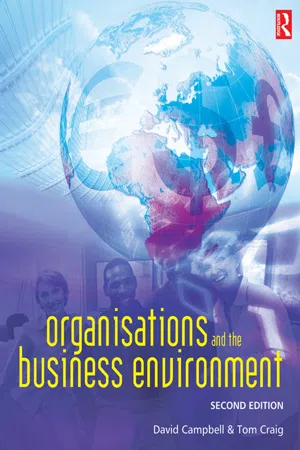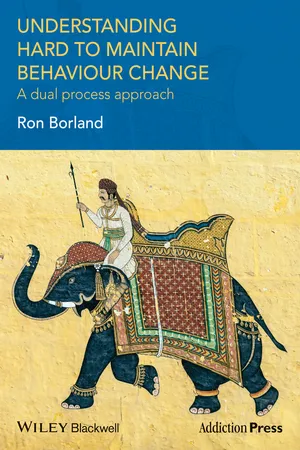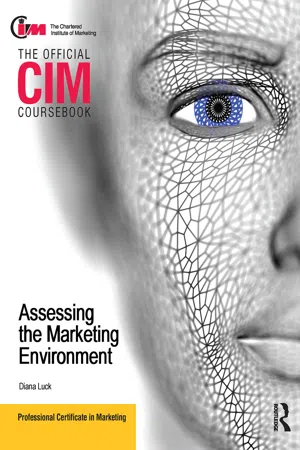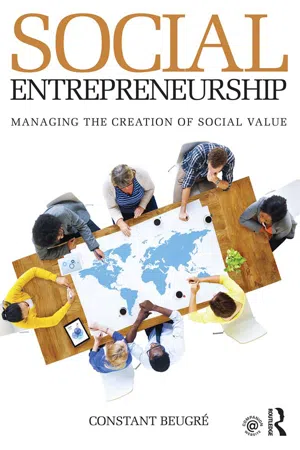Business
Social and Technological Environment
The social and technological environment refers to the external factors that impact a business, including societal trends, cultural norms, and technological advancements. Understanding and adapting to these influences is crucial for businesses to remain competitive and relevant in the market. Social and technological changes can create both opportunities and challenges for organizations, shaping consumer behavior, market demands, and industry dynamics.
Written by Perlego with AI-assistance
Related key terms
12 Key excerpts on "Social and Technological Environment"
- eBook - ePub
Entrepreneurship Marketing
Principles and Practice of SME Marketing
- Sonny Nwankwo, Ayantunji Gbadamosi, Sonny Nwankwo, Ayantunji Gbadamosi(Authors)
- 2020(Publication Date)
- Routledge(Publisher)
The Focus on Gender publication of the Office of National statistics shows that both men and women filled similar jobs estimated at about 13.6 million each compared to the case in 1985, when men filled more jobs than women with the difference of 2 million jobs (ONS, 2008). Meanwhile, the ONS data shows that gender pay gap fell to 8.6% for year 2018 in respect of full-time employees, while the figure is close to zero for full-time employees aged 18–39 (ONS, 2019). Family consumption pattern has equally changed in line with all these societal changes. Indeed, as SME often target relatively small customer groups, tracking these changes will give them directions on how to achieve competitive advantage. The knowledge of this environment will equip them such that the product or service they offer to the targeted niche could be distributed through the right outlet, priced effectively, and promoted in such a way that will reach the target audience effectively. For instance their marketing communication messages, which used to be designed to appeal to only husbands, might change to that which appeal to the couple in light of the changes in family buying roles.TECHNOLOGICAL ENVIRONMENTTechnological environment which embraces the technical skills and equipment that enhance the conversion of inputs into outputs is pivotal to the success of businesses and the society. The simple process of how this takes place is demonstrated in Figure 4.2 :Figure 4.2 Technology as a catalyst in the transformation processIt supports wealth creation and has a very strong influence on marketing activities. It is therefore not surprising that the trend all over the world shows that technology is constantly changing. We now have several inventions that make marketing transactions more efficient and effective compared to what used to be in place several years back. The changes to computing, telephoning, and printing in recent times are just some examples of how technological environment changes, and influences marketing of goods and services. Although due to financial constraints some of these businesses may not be able to afford some of the newly developed highly sophisticated equipment meant for production of goods that could give them economies of scale, they could engage in inter-organisational relationships (IOR) to achieve this. In such an arrangement, two or more establishments can pull their resources together towards buying the new inventions that will give them the opportunity to satisfy their target markets. The stiff competition in the market cannot allow small businesses to remain complacent with old equipment and processes. They have to be up to date with inventions and also explore the opportunities towards gaining competitive advantage in the marketplace. Linking this discussion to Figure 2.3, it is apparent that having the right inputs into the transformation process is important and significantly determines the type of outputs that will come out of the system. The BBC programme titled Dragons’ Den - eBook - ePub
Financial Services Management
A Qualitative Approach
- Stewart Falconer(Author)
- 2014(Publication Date)
- Routledge(Publisher)
10 Business and the external environment Social responsibility and business ethics DOI: 10.4324/9780203515532-10Introduction
Now that we have considered the significance and influence of the contextual environment on business management, I want to turn my attention to the more immediate or operational environment and, here, I am examining the relationship between business and those sectors of society with which business and its activities have a much more direct interaction. When thinking about the entities that might be included in the operational environment for organizations within financial services, we could have quite a number of participants. For example:Customers
Clearly, customers are one of the most important elements of the environment, if not the most important. If you are to meet their needs effectively and encourage them to buy and buy more from you, the organization must be aware of:- how customers evaluate the organization's products and services against those of its competitors;
- what they are looking for in the market and to what extent the organization is providing it effectively;
- how their tastes are changing;
- what customers are buying in the market, from whom and why.
As I said in the previous chapter, you can influence your customers’ behaviour by providing the products they are looking for but, at the same time, they can be very influential in the success or failure of your marketing strategy simply in terms of whether or not they buy your products. In addition, what they tell their friends about the business and its products can be similarly influential.Shareholders
The shareholders in a business have a direct interest in the strategy that the organization pursues, as the success or otherwise of that strategy has a direct impact on the growth in and returns on their investment. On the other hand, their influence on that strategy depends on their level of investment interest in the business. In other words, while every shareholder has the opportunity to comment on company performance, the extent of their influence is directly related to the size of their shareholding. Although it is a little out of date, a survey of the structure of shareholding in selected countries1 - eBook - ePub
- John Brinkman(Author)
- 2014(Publication Date)
- Routledge(Publisher)
Star Trek.11.2 What do we mean by the socio-cultural environment?The socio-cultural environment refers to the values, attitudes, norms and lifestyle of the population. Therefore, socio-cultural influences on the organisation are directly related to people and to their preferences.Key TermsThe socio-cultural environment refers to the values, attitudes, norms, and lifestyle of the population.Values are the abstract ideas about what a group believes to be right or wrong (Hofstede, 2001).Norms are the social rules and guidelines that prescribe appropriate behaviour in particular situations (Hofstede, 2001).Population is the number of people that live in a particular geographic area.But people change and so do their values, attitudes, norms and lifestyle. Some of these changes are relatively temporary and we can consider them to be mere fashions, while other changes show a longer-term decrease or increase in the population’s preferences. These changes are called trends (Campbell, 1997). For the purposes of this chapter, we will focus on the analysis of socio-cultural trends.ExampleKey TermsA fashion is the result of a temporary change in the population’s preferences. Trends reflect long-term changes in the population’s preferences.Since the 1980s there has been an increasing trend for people to exercise in order to keep fit. However, the popularity of different forms of exercise can be considered fashions: for example, aerobics in the 1980s was replaced relatively quickly in people’s preferences by step, and spinning in the 1990s, which in turn have given way to other ways of keeping fit, such as yoga and Pilates.Figure 11.1 Aerobics versus yogaAs we will see, some trends in the socio-cultural environment are directly related to other trends in the macro environment. For example, the rise in the ‘weekend city break’ as a leisure activity can be linked to the increase in spare income (economic environment), the advent of the internet (technological environment) and the increase in the number of people who are IT literate and who feel comfortable using the internet for business transactions (socio-cultural environment). The combination of these factors has created a market for the services of budget online operators such as easyJet, Ryanair and Thomsonfly. Other trends, such as people becoming more health conscious, cannot be so easily explained. - eBook - ePub
People Practice
A Complete Guide
- Karen Waite, Kathy Beevers, Nicky Small, Keith Tomlinson, Shazad Hussain(Authors)
- 2021(Publication Date)
- CIPD - Kogan Page(Publisher)
If we consider some of the organisations we know, and what has impacted or created pressure points on their business, we might think of political changes such as Brexit in the UK, world events such as Covid-19, ongoing technological developments, or maybe factors affecting staff such as skills shortages. Just this simple quick consideration reminds us of how turbulent and ever-changing the business environment can be and therefore the need for organisations to manage this turbulence if they are to survive and prosper.We can refer to the business environment as operating at two levels – macro and micro. Macro level refers to the societal level and the major uncontrollable external forces (economic, demographic, technological, social and cultural, legal and political) which will influence a company’s decision-making and impact its performance. Micro level is specific to an organisation’s internal and immediate environment, factors such as its suppliers, customers, competitors and resellers, which directly influence it on a regular basis. The micro level is sometimes also known as ‘the task environment’ as this is usually the area where an organisation can influence and respond, whereas it has very little control over the macro environment.Figure 1.1 The macro and micro environmentFigure 1.1 detailsThe micro environment of the organization shows the customers, resellers, the public and soldiers. The macro environment includes political factors, economic factors, social factors, technological factors, legal factors, environmental and factors.Regularly scanning the business environment affords organisations the chance to stay ahead of changes that may impact their business and to plan for these, either capitalising on or minimising their impact.There are a number of tools and techniques which enable this ‘scanning’, including the popular SWOT analysis. SWOT stands for Strengths, Weaknesses, Opportunities and Threats. Strengths and weaknesses are internal factors whereas opportunities and threats are external factors. A SWOT analysis assesses these four aspects of a business, identifying what the organisation is doing well or not well, and so informing further strategy and organisational development. Figure 1.2 - eBook - ePub
Strategic Marketing
An Introduction
- Tony Proctor(Author)
- 2002(Publication Date)
- Routledge(Publisher)
Organizations need to respond and adapt to changing environmental conditions if they intend to survive. They can even instigate changes in the environment which are in their own interests. Both demand an understanding of those factors and forces which bring about change in the environment. Ideally, an organization should adapt to changes as they occur, even anticipate them in advance or systematically instigate changes to its own advantage. An inability to do so can put organizations in positions where their shor t- and long-term survival is jeopardized. The business environment is the setting within which a business operates, formulates policies and makes decisions. It is usual to distinguish between the inter nal and the exter nal environment. The for mer usually comprises the various assets and resources possessed by the organization. That is its workforce, plant and machiner y, know- how, financial resources, etc. The latter refer s to people, institutions and developments, etc. which exer t an external influence on how the organization performs. Of course, with the emergence of strategic alliances and networks such a definition of boundaries does tend to become more blurred.Firms need to know all about the business environment in which they operate. It is essential that they can anticipate the changes that are likely to take place in the marketing environment in the foreseeable future. However, as noted above, it is not simply a matter of adapting to change. Organizations can also exercise their own influence on the environment. Among the ways that this can be achieved is the development and commercialization of new technological ideas. These new technologies then become par t of the business environment and in their turn have an impact upon what other organizations can do.Considerable control can be exercised over its internal environment by a firm, but a firm cannot exert control in the same way or to the same extent over the external environment. It can only attempt to influence it. There are various ways of influencing events in the external environment. These may include activities such as lobbying among leg islative g roups. The latter is what organizations often do when tr ying to influence the for mulation of European Community directives which can have an impact on such things as product design safety standards, etc. - eBook - ePub
- Tom Craig, David Campbell(Authors)
- 2012(Publication Date)
- Routledge(Publisher)
The Sociological Environment
DOI: 10.4324/9780080454603-11Learning Objectives
After studying this chapter, students should be able to describe:- the nature of the sociological environment;
- the nature of demography and how it can affect organisations;
- the relationship between education and organisation skill requirements;
- the changing patterns of employment;
- the impact of societal values, attitudes and behaviours;
- the fashions and trends in opinion and preferences that can affect organisations.
11.1 What Is the Sociological Environment?
In one sense, sociological influence on an organisation can come from any internal or external source involving people. This clearly includes a wide variety of possible stakeholder influences, such as customers, employees, suppliers, opinion leaders and trade unions.The sociological environmental presents two important facets which are relevant to business:- the features of the population, including its size, distribution, composition and changes (demography);
- the opinions, beliefs, cultural norms and preferences of the population.
11.2 Demography
What is Demography?
Demography is the study of human population dynamics. The scope of the subject includes:- the size of the population in the country (or a region) as a whole;
- growth or decline in the population (birth and death rates);
- the composition of the population by geographic location and distribution;
- the composition of the population by skill and education level;
- the composition of the population by concentration and density;
- the composition of the population by age and gender profile;
- the composition of population by its economic activity (e.g. the size and structure of the working population);
- changes in the population distribution by migration.
Why is Demography Important To Business?
The size, composition and distribution of the population are not just a matter of academic interest. Businesses take account of demography in a number of areas of activity. Its importance is linked to both the demand and supply sides of the market ‘equation’. - eBook - ePub
Strategic Analytics
Integrating Management Science and Strategy
- Martin Kunc(Author)
- 2018(Publication Date)
- Wiley(Publisher)
3 External Environment: Political, Economic, Societal, Technological and Environmental FactorsObjectives
- To define exogenous factors
- To learn tools for foreseeing changes in exogenous factors
- To organize external environment information for decision making
Learning outcomes and managerial capabilities developed
- To develop sensemaking managerial capabilities
- To classify the impact of external factors into threats and opportunities
Strategic choices are a function of conditions of the internal and external factors and the possibility of influencing them. The external environment, or external factors, can affect the organization's choices as well as its performance so it is fundamental to consider them within the strategic management process even though it will be impossible to affect them. The closeness of the external factors to the organization implies the possibility for the organization to influence, within a certain time horizon, conditions of these factors. The external environment can be divided into three parts according to the closeness to the organization: rivalry with existing organizations; industry dynamics defined by the suppliers, potential entrants, substitutes and customers; and the general or remote environment defined by the political, economic, social, technological and environmental factors (Figure 3.1 ).External factors affecting the organization.Figure 3.1External factors can not only be threats to the survival of the organization but also opportunities to achieve the vision defined for the organization or even redefine it. Therefore, organizations may need to design strategies to defend themselves against a threat or follow opportunities arising from favorable changes in the external factors. This chapter addresses the factors residing in the general or remote environment.Political
These factors examine the political situation since government regulations and legal issues play a role in its economy and can ultimately affect the organization. Examples of such factors are tax policies, environmental policy, labor laws, international trade barriers and tariffs. It is essential for organizations to asses and align themselves with these policies in order to devise strategies which will enable them to operate successfully in the market and, thus, avoid government pressures as an interested stakeholder. Government policies can become a huge impediment to the growth of an organization if they affect strategic choices in terms of business models. Government policies may also become highly beneficial if they are supporting the growth of the industry or creating barriers to avoid competition. - eBook - ePub
Understanding Hard to Maintain Behaviour Change
A Dual Process Approach
- Ron Borland(Author)
- 2013(Publication Date)
- Wiley(Publisher)
Influences that operate or which can be changed at the level of entire societies set the agenda around which the interactional environments of individuals and their social networks operate. Some of these societal factors are taken for granted, and only when people experience other societies do they realise that they are not inevitable. Societal-level influences are a result of the laws and customs of the society, institutional forces (including commercial ones), cumulated knowledge, various forms of mass media and increasingly the role of communications technology to allow more interactive communication at a distance. These set the context that individuals and their social circles interact in and provide limits on what is possible and/or desirable.In considering where to intervene on systems, it is important to work out where the power to enact change lies, and, where possible, to act at the highest level of that power structure. That said, where there is resistance at higher levels of systems, progress can be made by acting with or on lower level processes, but only where they are part of the relevant system of control.The relatively stable environment
The environment in which people live and behave consists of the physical environment (natural and built) and within it, the social environment, both of people and the ways they communicate.A range of aspects of the environment need to be considered in analysing the likely ease of behaviour change, for either increasing or decreasing behaviours. These are briefly described in the following paragraphs.Most critical is the extent to which the micro-environment provides opportunities to act, including accessibility of places to act (e.g. access to places to exercise safely and enjoyably) on the one hand, and places where the behaviour is not normative or is actively prohibited on the other. This also includes any degree of obligation to act (e.g. places where the behaviour is expected or allowed) and any demands of the physical environment (e.g. having to go outside to smoke in freezing weather or during a rainstorm). The greater the range of places where behaviours can readily occur, the more these behaviours are engaged in. Smokers smoke less when subject to bans from smoking at work and other places [2, 3]. For recreational exercise, living near a gym or a pleasant park is associated with higher levels of exercise [4, 5]. Having safe paths for bicycle transport is leading to marked increases in the proportion of people cycling to work and other places, as well as for recreation. - eBook - ePub
Tourism Marketing for Cities and Towns
Using Social Media and Branding to Attract Tourists
- Bonita Kolb(Author)
- 2017(Publication Date)
- Routledge(Publisher)
The tourism marketer must also scan the external environment including, economic conditions, demographic trends, technological advancements, and socio-cultural changes. Economic factors that need to be understood include both the current state of the economy and whether it is in growth or decline. In addition, the level of disposable income available for travel must be ascertained. Technological advancements affect the consumer’s expectations of the benefits that products will provide and also the purchase process. Demographic changes in the population can provide the opportunity to target new segments of travelers. Finally, socio-cultural changes will affect people’s values, attitudes, and lifestyles. All of these issues will need to be researched before the organization is ready to start writing a strategic marketing plan. Sources of information on the external environment include analyzing the general and business news. This scanning is necessary as it is a marketing responsibility to be the person who sounds the alert if political or business events present a new challenge or opportunity.External environment- Economic: growth or decline, level of disposable income
- Demographic: age, family status, ethnicity
- Technological: product expectations, purchase process
- Socio-cultural: values, attitudes, lifestyle
Conducting research is also part of the process of scanning the external environment. Rather than interviewing the marketer will use data that is available from other organizations. This information, most of which can be obtained through conducting online research, can be used to answer questions on the economy, technological advancements, demographic changes, and socio-cultural trends. Trade and professional associations in the tourism industry will provide information on consumer trends and preferences. This information is collected as a service to their members. While these association websites, trade journals, and professional magazines have articles on demographic data, their most common use is to learn about trends in both the industry and destination choice. - Diana Luck(Author)
- 2010(Publication Date)
- Routledge(Publisher)
CHAPTER 5The Demographic, Social and Cultural Environment
Learning Outcomes
Appreciate key demographic changes and their implications for marketing.Recognise the interrelatedness of the socio-cultural environments.Appreciate the processes leading to the development of social and cultural values.Assess the meaning and implications of socio-cultural change.Understand and apply concepts such as lifestyle, reference groups and social class.Consider emerging trends and their potential impact on the marketer.STUDY TIPKnowledge and understanding of demography and socio-cultural change is vital if the marketer is to truly appreciate the origins of buyer behaviour. Even though these are uncontrollable by marketers, their appreciation and understanding is essential. Both evolve very slowly but their cumulative impact on the market is considerable. Living standards in the longer term are more likely to be determined by population changes than the economic policy-making of governments. Change in this environment is the most difficult to assess, yet it offers many opportunities to marketers. The relevant variables are usually interrelated and it is often difficult for marketers to assess the contribution of any one element.You will be able to identify most of the different dimensions throughout this chapter. But, you will also need to supplement your familiarity with these factors with more reading. The periodical The Economist is useful with regard to the economic trends and New Society to extend your knowledge of social trends. The government collates statistics and publishes reports about social trends (http://www.statistics.gov.uk/socialtrends/- eBook - ePub
The Entrepreneurial Personality
A Social Construction
- Elizabeth Chell, David E. Wicklander, Shane G. Sturman, L. Wayne Hoover(Authors)
- 2008(Publication Date)
- Routledge(Publisher)
Hence, I shall focus on the socio-economic framework in which entrepreneurs take business decisions. Layers of context from the macro- to the micro-environment will be assumed to form the structural background. The aim is to dig deeper into this complexity, assuming a theoretical frame of structure and agency. The treatment of the macro-environment will include understanding of the institutional framework that constrains or enables human action; at the meso-level I focus on the firm as an organising framework in which entrepreneurial decisions are taken, and at the micro-level I shall deduce the implications for entrepreneurs and entrepreneurial teams as dynamic economic decision-makers and agents of socio-economic change. The macro socio-economic environment Macro-environments as traditionally dealt with by economists have made deterministic assumptions about national and international contexts framing competitive behaviour. Trading conditions and the degree of environmental ‘turbulence’ have been pointed up as immutable contexts that shape and influence business and firm behaviour (Burns and Stalker, 1961; Miller, 1983; Casson, 2005). The environment is formed by a complex of socio-economic, political and legal sub-systems that are interwoven yet analytically distinct. Indeed, they are further complicated by the physical, the technological and the religious environments. There is a sense in which the environment is ‘out there’ (i.e. has a history and duration independent of the firm or entrepreneur), and another sense in which environments are internalised, produced and reproduced by actors and agents (Giddens, 1984; Craib, 1992). In grasping this complexity, we wish to consider how we might think of environments analytically: what the process is by which entrepreneurial behaviour is shaped and constrained or, indeed, enabled by the socio-economic environment. In pursuing this understanding, we should consider a number of theoretical issues - eBook - ePub
Social Entrepreneurship
Managing the Creation of Social Value
- Constant Beugré(Author)
- 2016(Publication Date)
- Routledge(Publisher)
62 The emergence of social entrepreneurship can be affected by the entrepreneurship climate in a given country. Social entrepreneurship can flourish only in a strong entrepreneurial climate. It founders in a weak entrepreneurial environment. For example, the United States is considered as one of the most entrepreneurial countries in the world, and social entrepreneurship flourishes there, too. By contrast, in most African countries the entrepreneurial climate could be considered as weak. Consequently, social ventures do not flourish in these environments. (Of course, this is not to say that there are no social ventures in Africa.)2.4 Technological Environment and Social Entrepreneurship
The PEST model contends that the technological environment influences firms’ strategies and operations. Extended to social entrepreneurship, one could argue that the technological environment influences social venture creation in several ways. First, technology, especially information technology, facilitates increased awareness of the existence of social problems not only locally but in other parts of the world. Second, technology can facilitate the creation of social ventures because social entrepreneurs can easily use the internet to advertise their social ventures. Third, technology facilitates partnerships among social entrepreneurs located in various parts of the world.Advances in information technology have increased awareness of social problems around the world and facilitated interactions between social ventures located in different geographic areas. Increased public awareness of a social problem acts as an external added incentive, which makes engagement appear more worthy because of an added social component.63 These interactions have also encouraged the founding of many social ventures.64 Technology has also created a sense of shared responsibility in addressing social problems. Because people now have easy access to what is happening in different parts of the world, they are compelled to take action when they see human suffering. For example, many people saw the effects of the Boxing Day tsunami in December 2004, the Haiti earthquake in 2010, and Hurricane Katrina in 2005 on television or online. Such awareness creates a natural response among many concerned individuals. Even actions by established companies that violate ethical practices are easily publicized. For instance, the Western media has widely publicized the plight of Pakistani children who work in sweatshops to produce soccer balls, making it very difficult for the multinational corporations that operate the factories not to take action.65
Index pages curate the most relevant extracts from our library of academic textbooks. They’ve been created using an in-house natural language model (NLM), each adding context and meaning to key research topics.











